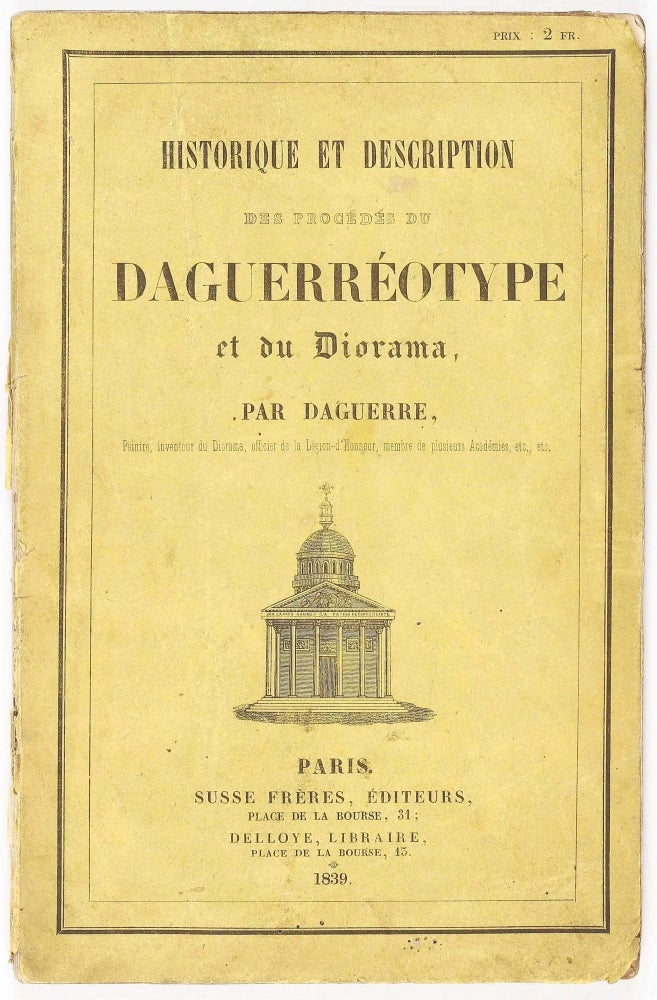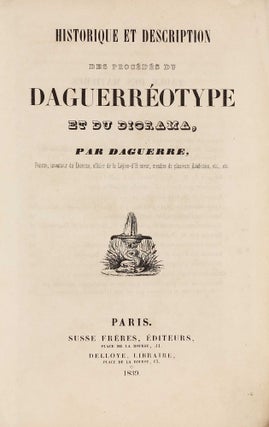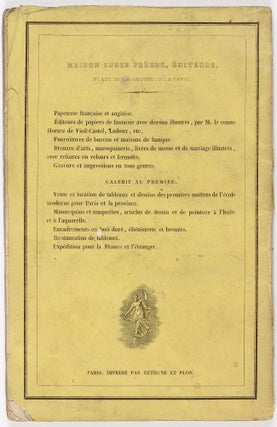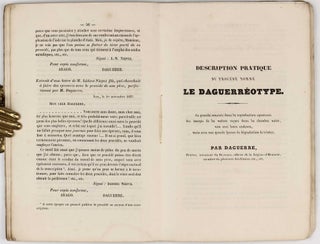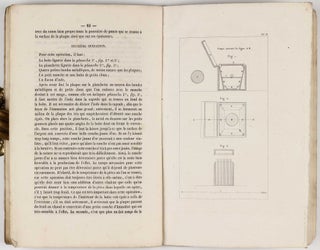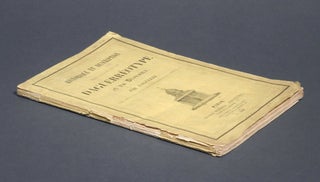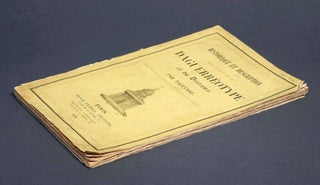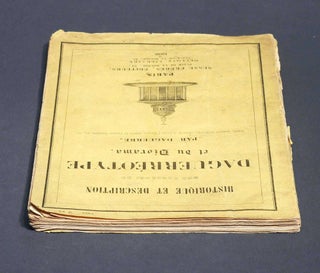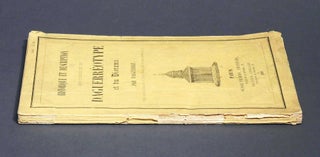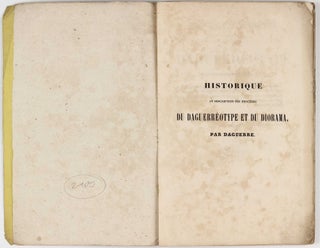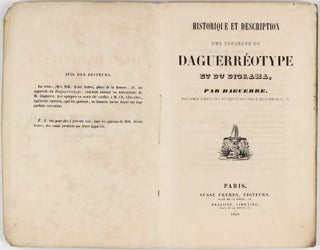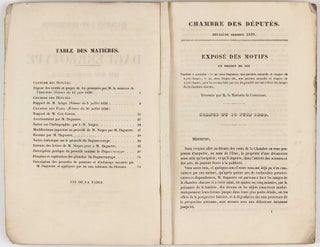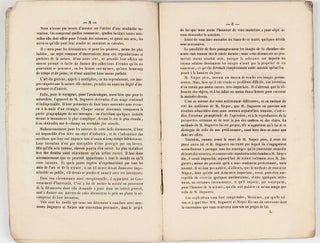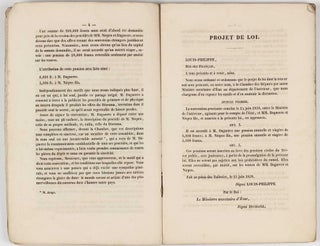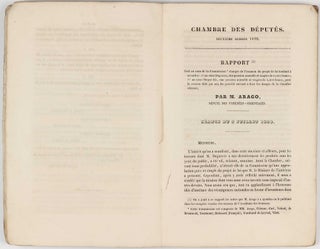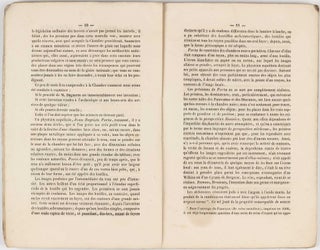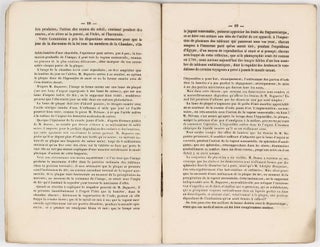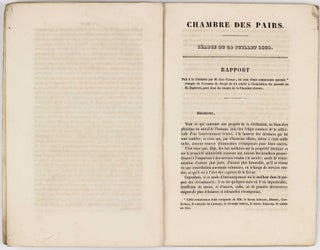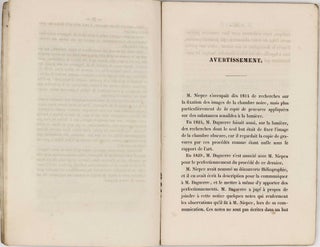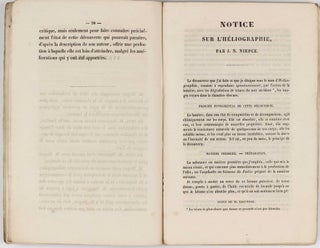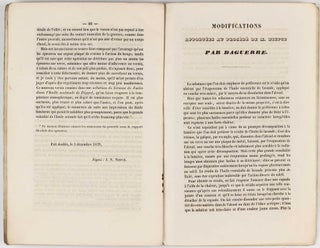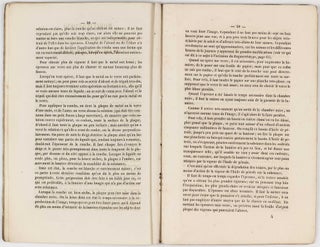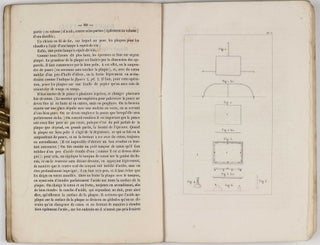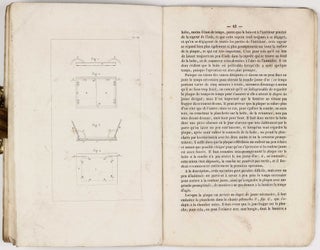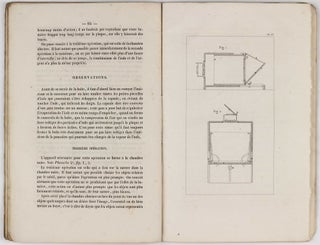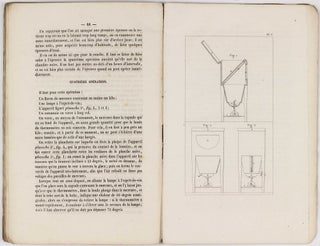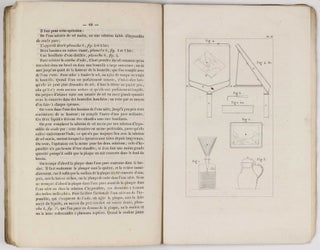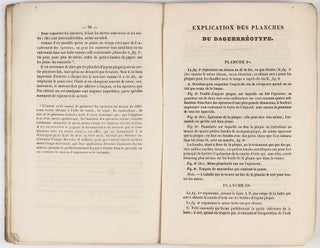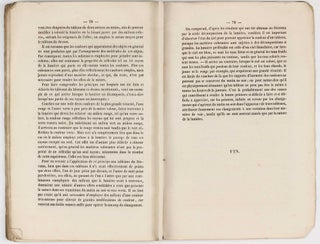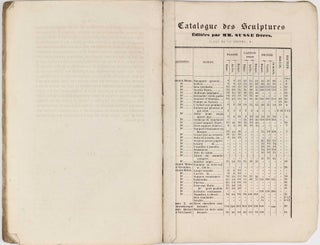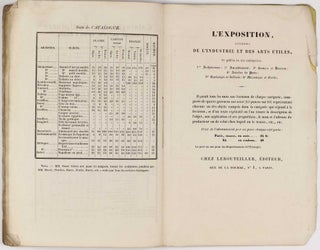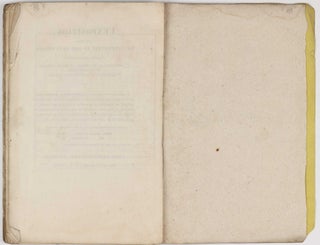The first edition, first issue in untouched yellow wrappers as issued
Historique et description des procédés du daguerréotype et du diorama.
Paris: Béthune and Plon for Susse frères and Delloye, 1839.
1st Edition. Soft cover. Near Fine. Item #003106
8vo (212 x 138 mm). [4], 79 [1], [4] pp., including half-title, 6 lithographed plates and 2 advertisement leaves at end. Original printed yellow wrappers (dust-soiled, some chipping of blank paper over spine with loss, small hole in rear cover), protected in custom slipcase. Text very little toned, half-title somewhat spotted, p.63 and facing plate III slightly dust-soiled, a little dust-soiling to outer margins elsewhere, faint dampstain to blank upper gutter of a few pages, two leaves with short tear without loss, some dog-earing to corners. A fine, completely unsophisticated copy. ----
"THE BEGINNINGS OF PHOTOGRAPHY" (Horblit). "PERHAPS NO OTHER INVENTION EVER CAPTURED THE IMAGINATION OF THE PUBLIC TO SUCH A DEGREE AND CONQUERED THE WORLD WITH SUCH LIGHTENING RAPIDITY AS THE DAGUERREOTYPE" (Gernsheim).
FIRST EDITION, FIRST ISSUE, second imprint of Daguerre's exposition of his photographic process.
AN ATTRACTIVE COPY IN ITS ORIGINAL PRINTED WRAPPERS OF THIS GREAT RARITY. Dibner 183; En français dans le texte 255; H. & A. Gernsheim, The History of Photography, chapter 6; Horblit/Grolier 21a (reproducing the 4th issue); Norman 569 (same issue); PMM 318b; Sparrow 46.
We know of only three other unsophisticated copies of the first issue in its original wrappers that have appeared at auction in the past 40 years: the Honeyman copy (Sothebys 1979, lot 802, GBP 1,400), the Meyer Friedmann copy (Sothebys 2001, lot 40, $55,375) and finally the Richard Green copy (Christies 2008, lot 66, $122,500). In contrast to ours, which is completely unrestored, the Richard Green copy featured the yellow wrappers in a cleaned and repaired state.
Daguerre's manual, published by order of the government, was quickly sold out. A total of 39 reprints, new editions, and translations appeared in the following 18 months. The great demand accounts for the profusion of issues of the first edition: 7 are recorded, all from the same basic setting of type. Of these the first four differ in the booksellers' names alone. The present copy is of the first Susse issue which was released on 14 September 1939. It is the second to appear, preceded only by the Alphonse Giroux issue, published shortly after Arago's 19 August announcement, of which only two copies are known (see Honeyman 802), both preserved in the George Eastman Museum, Rochester.
"At a joint meeting of the French Academies of Arts and Sciences, Count François Arago announced the miraculous invention of Daguerre, a method for making faithful impressions of objects on sheets of copper, coated with light-sensitive silver salts. Arago's announcement trumped the efforts of Talbot, much to the Englishman's chagrin" (Parr-Badger vol. 1, p. 13).
Louis-Jacques-Mandé Daguerre, inventor of the Diorama, a picture show based on lighting effects, started experiments in the 1820s with fixing the images of the camera obscura on silver chloride paper. His lack of success using this method stimulated his interest in the heliographic method invented by Nicephore Nièpce, who had produced the first successful photographic image in 1826 or 1827 on a pewter plate coated with bitumen of Judea dissolved in oil of lavender. In 1829 Daguerre succeeded in persuading the reluctant Nièpce to become his partner. However, it was only after Nièpce's death, in the spring of 1835, that Daguerre accidentally discovered a quicker method of exposing and developing the Niècian image through the application of mercury vapor. Using this method, with common table salt as the fixative, he produced his first successful permanent photographic image in 1837. Still under contract with Nièpce's son Isidore, Daguerre agreed to split the profits from the new invention in exchange for calling it by his name alone. He then proceeded to launch a publicity campaign with the goal of attracting 400 subscribers at 1,000 francs each, stipulating that the processes of heliography and 'daguerrotype' would not be revealed until 100 subscribers were enrolled. This failed, and the resourceful Daguerre turned to other methods, privately approaching a number of leading scientists with the goal of interesting the government. "He was fortunate in finding in François Dominique Arago an influential ally, for he was a member of the Chamber of Deputies as well as a distinguished physicist and astronomer. Soon afterwards, Arago gave the discovery official status by a brief announcement at the Acadmie des Sciences, on 7 January 1839" (H. & A. Gernsheim, The History of Photography, p. 68). Arago energetically promoted the invention and succeeded in obtaining government funding for the two partners, although in the course of his arguments he gradually shifted credit for the invention to Daguerre, at the expense of Nièpce's pioneering work. By the summer, Daguerre was finally obliged to divulge the details of "his" process (though not before Fox Talbot, in reaction to the news of Daguerre' invention, had published his own announcement of his independent invention of a photographic process). On August 19 Arago made a full announcement to a packed house at a joint meeting of the Académies des Sciences and des Beaux-Arts at the Institut de France. The excitement was palpable. "Perhaps no other invention ever captured the imagination of the public to such a degree and conquered the world with such lightening rapidity as the daguerreotype" (H. & A. Gernsheim, The History of Photography, p. 71). Along with the official documents relating to the government's review of the procedure, Daguerre's manual includes details of its genesis, including a transcription of Nièpce's own description of his heliographic process, submitted to Daguerre in 1839, and a full illustrated description of his daguerreotype process - presented as an independent invention, superior to Nièpce's.
Sold
Delivery time up to 10 days. For calculation of the latest delivery date, follow the link: Delivery times
Lieferzeit max. 10 Tage. Zur Berechnung des spätesten Liefertermins siehe hier: Lieferzeiten


